Goshawk
 The ultimate phantom arboreal predator, nimble and powerful and the largest hawk in Europe.
The ultimate phantom arboreal predator, nimble and powerful and the largest hawk in Europe.
A lovely “old boy” I know, one of those true country folks, born and bred type who could read tracks and signs and spend hours telling you about the old days when he was a kid running about in the countryside, used to tell me stories of his “Gos”, which he trained and hunted with to control the rabbits on the downland near us. He loved his birds like they were his family, and it inspired me to get a sighting of a wild one. After I initially met him, I spent hours on the New Forest trying to get a sighting, but I was never lucky enough. Over the years, however, it is like goshawks have now come to me and I’ve had a few close encounters. But to get these sightings I had to figure out what they looked and sounded like...
The goshawk (Accipiter gentilis) is a high-speed woodland predator, roughly the same size as a buzzard, with a wingspan of 90-105cm (male) and 108-120 (female). Females have slate-grey upperparts and whitish underparts barred grey, whilst males are considerably smaller, with blue-grey upperparts. Juvenile birds have striped rather than barred underparts, but all have long thick yellow legs and sharp talons, and a white line above each sinister-looking blood red eye.
The goshawk looks similar to the sparrowhawk, but it is much larger, and in flight they appear more powerful and purposeful, with broad wings and a long, rounded tail (sparrowhawk is more square cut). As with most birds of prey, the female goshawk is larger than the male, measuring 49-56cm (male) and 58-64cm (female) in length, and weighing 850g (male) and 1.5kg (female).
The name ‘goshawk’ comes from the Old English name ‘goose-hawk’.
Goshawks were all but extinct as a breeding bird in the UK by the end of the 19th century due to loss of woodland habitat and persecution. Deliberate and accidental reintroductions have seen the population slowly recover, with an estimated 542 birds in 2017. Goshawks have a scattered population across the UK, normally found in woodlands interspersed with open areas, such as clearings, fields, rivers and hedgerows, with the greatest numbers in Wales, northern England, southern and eastern Scotland, and the New Forest in Hampshire.
But as a famously elusive species that is hard to spot, often spending much of their time perched, rather than soaring, living and hunting in woodlands, I would dare say that populations have increased more than we think as they are difficult to find, and sightings across the country are increasing.
Although we consider goshawks to be birds of the forest, in other parts of Europe they can be found in urban settings, perching in trees and on streetlights, catching feral pigeons, squirrels and rats. A friend of mine lives in Berlin (one of Europe’s most wooded cities) and regularly watches goshawks right outside his kitchen window while they use the nearby trees as their plucking posts – or they watch him, as he says, with their menacing stare! Apparently, there are about 100 pairs in the city, and did you know Berlin boasts the highest density of goshawk territories anywhere in the world – urban or rural!
So, what do they eat and when do they breed?
The goshawk is an ultimate predator, tailor-made to effortlessly weave through woodland, flying through the trees at up to 40km per hour as they hunt almost anything it outsizes, which includes other birds, such as wood pigeons, corvids and gamebirds; squirrels, rabbits, and other mammals; and I have even seen barn owls on its prey list. The goshawk builds its nest close to the trunk of a tree, laying two to four eggs per clutch and raising their young between March and June, the females staying in the nest while males hunt for food. The fledglings become independent after around three months and reach sexual maturity at two years old.
As powerful predators, goshawks are often used for falconry. In the Middle Ages, only nobles were allowed to use them, hence their Latin name, which means ‘noble hawk’.
Over the last couple of years here at the GWCT, I have been out doing lots of surveys and monitoring as a part of my job and I have had the pleasure of several close encounters. One flew straight past me in a woodland, one soared closely above me, following me, as I was doing a butterfly survey, and one of the most memorable times was when I heard one, with its jittering call, above me, while I was in an ancient yew woodland looking at a carpet of snowdrops.
So, if you want to see a goshawk, the best chance of spotting one is on a clear, still day between late winter and early spring, when the birds can be seen flying high over the trees as they perform their display flight to attract a mate.
This Species of the Month is dedicated to Martin, one of my favourite “Noble” country gents.
Megan Lock
Advisory
Photo credit: Stu Nugent